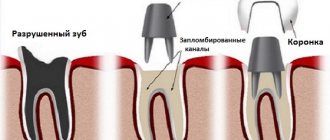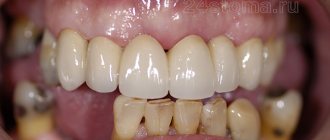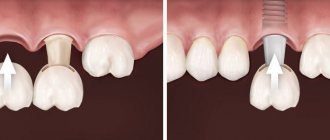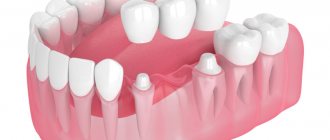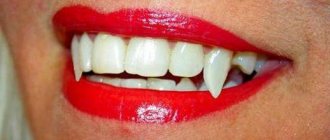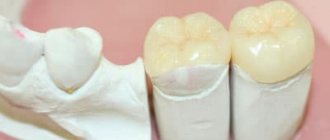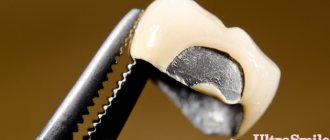If, when discussing a treatment plan, the doctor considers the possibility of tooth extraction, most likely we are talking about the treatment of a complicated form of caries - periodontitis. With periodontitis, infection from the tooth canals enters the bone tissue at the tops of the roots. As a result of inflammatory processes, bone tissue is destroyed and replaced by other tissues (granulomas or cysts are formed).
The danger of granulomas and cysts is that there is always a source of infection in the jaw. In addition to the possibility of an unexpected aggravation, these formations, increasing in size, can lead to tooth displacement and even jaw fracture. Read more about this in the article Living with a cyst and not knowing about it.
Delete or Treat?
There are two approaches to the treatment of periodontitis:
- Remove the problematic tooth and place a crown on an implant in its place. Such treatment, according to doctors, is faster and easier, and the result is more predictable.
- Doctors who recommend fighting for a tooth insist that your own tooth is always better, and it’s never too late to get an implant. They suggest using “every option” to save the tooth.
However, dentists do not always clearly explain that treating a “problem tooth” will require significant time and financial costs, but may not lead to the desired results. If efforts to save the tooth turn out to be in vain, then the cost of “prosthetics on an implant” will have to be added to the cost of “treatment”, since the absence of even one tooth in the jaw affects the position of neighboring teeth.
The choice of “treat” or “remove” is not very simple, since it depends on many factors. Let's figure out what guides a dentist when offering his treatment plan.
Requirements for dental restoration methods
When renovating, two things are important - aesthetics and functionality.
Aesthetics - the appearance of the prosthesis. It should not differ from neighboring crowns and should resemble natural ones in anatomical shape and color. If artificial gum is present, it should be invisible when smiling - the contour is thin and neat.
Functionality consists in restoring the bite - tightly closing the chewing rows and correct positioning of the jaws relative to each other. The load should be distributed evenly.
When choosing a method, take into account that prosthetics is inferior to implantation. The pressure on the supporting teeth increases, and the bone tissue under the prosthesis atrophies. Atrophy will lead to deterioration of hygiene and the risk of inflammatory processes. Implants do not have such problems. The role of the root is played by an artificial rod in the bone, so when chewing, the same force is applied to the jaw as with a healthy tooth. This type of prosthetics is better in terms of functional restoration. In terms of aesthetics, implants also benefit.
When the probability of successful treatment is high and the doctor suggests saving the tooth
An example of an “ideal” case in which it is worth fighting for a tooth:
- The crown part of the tooth is well preserved (does not have severe destruction).
- On the x-ray, the bone tissue around the tooth is almost unchanged.
- The root canals of the tooth are free of filling material, smooth and wide.
- All teeth in the oral cavity are preserved and the diseased tooth bears normal physiological load.
- The tooth had not previously bothered me.
- The patient is practically healthy.
- The patient trusts the doctor, accepts the risks of treatment and wants to try to save the tooth.
Most likely, in this case, most doctors will undertake dental treatment, because the chances of success are high.
Bridge or implant
Bridges are a non-removable type of prosthetics. The dentures rest on the ground down crowns of adjacent teeth and are glued to them with special cement. They are made of metal ceramics, zirconium or pressed E-max porcelain. With the help of such structures, you can restore one or several teeth in a row, a maximum of four.
Advantages of bridges:
- cheaper than implants;
- look natural;
- do not require lengthy preparation or surgical intervention;
- simple care, preventive examination every six months.
Flaws:
- depulpation of supporting units is possible;
- preparation of healthy enamel of supports;
- jaw bone atrophy;
- wear out, service life is 10-20 years.
If there is a financial opportunity, we recommend installing implants. With this method, a titanium root is inserted into each hole and a metal-free crown is placed on it. Such structures are much stronger than fixed bridges and there is no need to damage adjacent units of the dentition. It should be remembered that under the “empty hole” an atrophic process develops. With an implant, this is excluded: pressure is constantly created, and bone tissue degradation does not occur. You can install a bridge supported by implants, in which case the treatment will be cheaper than implanting each tooth.
When the likelihood of successful treatment is low and the doctor may suggest tooth extraction
Examples of a less favorable situation:
1) The crown of the tooth is severely damaged. All that was left of the tooth was the root. This means that the tooth will have to be restored with a crown on the stump tab.
tooth restoration with a core inlay and crown
You will find more detailed information in the article What guides a dentist when he suggests restoring a tooth: with a filling, inlay, veneer or crown?
2) The x-ray shows significant destruction of bone tissue. This means that bone restoration will take longer and worse.
3) Root canals have a complex shape and removing all the infected pulp (“dental nerve”) from them is a difficult task.
4) The roots of the tooth are thin and curved. Expansion of the canals when removing infection from them can lead to the fact that the walls of the tooth cannot withstand the chewing load.
There are many difficulties in endodontic treatment; it is not for nothing that this area of dentistry is considered one of the most difficult. In the article Why you can’t give a 100% guarantee on tooth root canal treatment, we talk in detail about the difficulties of endodontic treatment, but here we will only demonstrate what a bizarre shape canals can be.
shape of the canals of the teeth of the upper and lower jaw
5) The tooth canals were previously filled. Canal retreatment is the “highest aerobatics” in endodontic treatment. It is not always possible to even unseal them. Sometimes this treatment leads to tooth extraction.
6) After unsuccessful endodontic treatment, a pin or a fragment of an instrument is fixed in the root canal. Removing foreign bodies from canals is a complex procedure with an unknown result.
7) Several teeth are missing in the oral cavity and an increased load is placed on the diseased tooth. Any depulped (“dead”) tooth copes with its function worse, since after removal of the “nerve” it becomes more fragile.
 The presence of granuloma and cyst further weakens the tooth.
The presence of granuloma and cyst further weakens the tooth.
9) The tooth periodically worries and the patient is “tired” of it.
10) The patient has concomitant diseases. And since any chronic disease weakens the immune system, the likelihood of successful treatment decreases.
The indication for tooth extraction may be one or more of the listed reasons.
Which is better: crown or tooth extension?
People lose teeth for various reasons - advanced caries, mechanical trauma, chronic inflammatory process. If a tooth is partially destroyed, then there are two methods of restoring it - a crown or extension. It is up to the doctor to determine which of these methods is applicable and preferable in each specific situation. Prosthetics and extensions have their pros and cons.
Protecting a tooth with a crown or building materials? Both methods have their advantages and disadvantages.
- Tooth extension is a series of medical manipulations and procedures (therapeutic, restorative), the main task of which is to hide visible defects and return the tooth to its normal appearance.
New techniques make it possible not only to restore a damaged tooth, but also to straighten it and give it a pleasant shine.Materials for teeth extensions are mostly hypoallergenic and do not harm the body.
- A crown is a protective shell or “shell” that is put on and secured to a damaged tooth with cement or a pin. You will have to spend a lot of time on making a crown and prosthetics. But at the same time, this is a more accessible manipulation than extensions; with its help, even too damaged teeth are restored, returning a beautiful smile or chewing function.
Both methods have their merits. In cases where the tooth is not severely damaged, the doctor resorts to extensions. If 70-80% of the tooth is destroyed, then a crown is often placed.
Crowns are made from a specially durable material that does not cause allergic reactions in the body. First, the dentist makes impressions of the future prosthesis or one crown, and then makes it himself or with the help of a dental technician in a special laboratory.
While the permanent crown is being made, the patient is fitted with a temporary composite crown.
Before installing a manufactured crown, the patient’s tooth is prepared (ground) to the desired size. Usually, the tooth is first depulped, dental canals are treated, after which its surface is treated with a special substance. All of these procedures may require multiple visits to the dentist's office. As a rule, a crown is installed in case of tooth decay of more than 80% or in the absence of a root.
If the destruction is minor, restoration is carried out using the extension method.
First, the doctor takes an x-ray. It shows the exact location and condition of the root, nerve, and the degree of destruction of the tooth cavities.
An x-ray will help determine the exact location and condition of the root and nerves of the tooth.
If no serious problems are identified using x-rays, the restoration procedure begins.
Preparatory stages:
- Cleaning and removal of dead, damaged hard tissues is carried out
- Fillings are placed in the right places under local anesthesia
- The oral cavity is freed from saliva and fumes from breathing in order to treat the tooth surface with a special solution
The preparatory stage is followed by the build-up itself:
- The size of the tooth is determined and the exact shade of enamel is selected to match the color of the patient’s healthy teeth
- Grinding and polishing of the damaged tooth is carried out
- Additional dental procedures are performed
There are direct and indirect ways to build up a damaged tooth. With the direct method, filling materials are used. Indirect extensions are performed by an orthopedist or dental technician.
Do not augment a tooth if:
- It is not possible to restore more than 40% of the surface of a dental unit
- No root
- Caries has affected too much of the tooth
- Bruxism detected
- A cyst has formed at the root of the tooth
- The patient has an allergic reaction to the drugs used during extension or individual intolerance
In all other cases, the tooth can be restored by extension, even in children.
Crowns cannot be installed if:
- Malocclusion
- The dentition is pathologically loose
- The enamel layer is very thin
- An allergic reaction to the crown material occurs
- Periodontal diseases detected
Reference! You can always choose a crown material that will not provoke allergies.
After extensions, with the correct selection of materials, teeth look natural
Extensions, as one of the ways to preserve a tooth, have undoubted advantages:
- The strength characteristics of the tooth, which means its functionality is fully restored thanks to the use of modern dental materials
- With careful handling (do not chew hard bones, nuts, or try to open a bottle cap with your teeth), the extended tooth will last for a very long time.
- Its own dental tissue is preserved, even if the tooth is ground down
- Thanks to careful selection of the shade of building materials, the restored tooth looks natural
Extensions have a few disadvantages:
- The procedure will cost more than installing a crown
- The service life depends on the professionalism of the specialist, the quality of materials, careful care and proper diet after the procedure. After restoration using the augmentation method, such a tooth must be protected
Advantages of crowns:
- Several teeth are restored at once
- A well-chosen and well-installed crown is difficult to distinguish from a real tooth.
- Stops further destruction of hard tooth tissue
- Very few contraindications
- The procedure is not painful
- If there is no root, the crown can be installed on an artificial root installed instead - an implant
- The cost is affordable
Disadvantages of crowns:
- Allergic reactions to crown material occur
- If the selection of crown material or size is unsuccessful, inflammation may develop and the tooth will begin to hurt
- Patients under 16 years of age are not given crowns.
- Difficulties in selecting materials - one is not strong enough, the other does not meet aesthetic requirements
- It takes some time to get used to a foreign body in the mouth
- Sometimes, during crown installation, neighboring healthy teeth are injured.
If it happens that the tooth is destroyed, but the root and nerves are in order, then you need to immediately go to the dental clinic to get help to restore it. After a careful examination, the doctor will determine the most appropriate method of restoration, and the tooth will be saved. If the process is started, then restoring it will not be easy, and sometimes impossible.
Related Articles
Which crown is best to choose for installation on a dental implant?
Temporary crown for dental implant
What is better: veneers or lumineers?
Add a comment Cancel reply
What is better to choose in the end?
To summarize, to understand the difference between the methods and what is better to choose, let’s collect the advantages and disadvantages in a table:
| Characteristic | Implant | Removable denture | Bridge prosthesis |
| Impact on adjacent teeth | No | Yes | Yes |
| Traumatic installation | Injury to gums and bone during installation | Turning healthy enamel for clasp | Preparation of adjacent teeth |
| Restoration of chewing function (from 1 to 10) | 10 | 4-8 | 9-10 |
| Bone atrophy | No | Yes | Yes |
| Reliability of fixation (from 1 to 10) | 10 | 4-8 | 9-10 |
| Comfort | 10 | 4-8 | 10 |
| Aesthetics (from 1 to 10) | 10 | 4-6 | 9 |
| Difficulty of care | Ordinary | Reinforced | Ordinary |
| Life time | from 30 years old | up to 10 years | up to 20 years |
| Price | High | Cheaper than implants and bridges | Cheaper than implants, more expensive than removable prosthetics |
The opinions of doctors are clear - the advantages of implantation over prosthetics are obvious. This is a reliable method with a service life of 30 years to lifelong use and does not injure healthy teeth. Aesthetics and ease of use are maintained. An implant is a complete imitation of a tooth, so this method is much better in functionality and appearance compared to even the most expensive prosthesis.
Why is it important to restore missing teeth?
Each lost crown along with the root threatens complications:
- Malocclusion - neighbors in the same row shift towards the empty socket. On the opposite side, on the other jaw, they move up or down. In this case, the rows do not close as expected.
- Diseases of the temporomandibular joint with headaches and tension in the muscles of the face and tongue.
- Digestive disorders - when there is nothing to chew, food is swallowed in rough pieces. Salivary enzymes do not have time to break down carbohydrates, and the function of the stomach, pancreas and duodenum is impaired.
- Changes in the shape of the face - a person looks older, facial wrinkles appear near the lips, cheeks sag and sag.
- Destruction of neighboring teeth, on which the chewing load increases.
- Bone atrophy and subsidence of the gingival papilla.
- Speech defect - there is a lisp and nasal sound.
- Psychological discomfort - lack of self-confidence, withdrawal from other people.
It is important to restore lost teeth. The doctor will tell you which method is best during your consultation, depending on your specific situation. The choice is yours.
A healthy tooth is more important for overall chewing function
Since a comparative analysis of colleagues from Chicago did not reveal significant differences and success rates of dental treatment between these two options, the dental association, based on these studies, unanimously expressed its opinion on the fight for the health of natural teeth, with the amendment - “The recommended treatment should be safe, taking into account the wishes of the patient , and should be aimed at preserving the natural tooth whenever possible,” from Dr. Goldstein ( President of the Association
).
Dentists emphasize that the decision to prescribe a dental treatment method should be based on quality research, taking into account the individual case of the complexity of the dental disease and the individual health status of the patient and his preferences.
Excerpts for this article were taken from the American Association of Endodontists 2013 Report
. The American Association of Endodontists, headquartered in Chicago, is composed of more than 6,900 dentists worldwide. Founded in 1943, the association is dedicated to excellence in the art and science of endodontics to achieve the highest level of patient care. The Association encourages its members to pursue professional growth and self-realization through education and research.
Implant and bridge: which is better?
What is better to install: a bridge or an implant? The answer to this question is almost obvious and depends on the patient’s capabilities and the state of his dental system. The best option is to install an implant followed by fixation of the abutment and crown. But this procedure may not be possible if there are contraindications or due to high cost.
Bridges are an alternative treatment option. It is important to keep in mind that over time the structure will need to be replaced, and due to uneven distribution of the load, the jaw bone tissue may dissolve.
On chewing teeth
The chewing teeth bear a lot of stress. Bridge prosthetics will be recommended only in situations that make implantation impossible. It is important for the patient to understand that the service life of a bridge on chewing teeth will directly depend on the condition of the supports, therefore therapeutic treatment is recommended before orthopedic intervention.
Implantation will allow you to restore not only aesthetics, but also preserve the functions of your teeth. Installation of implants guarantees correct distribution of the load during chewing, which means there will be no atrophic processes.
On the front teeth
When restoring front teeth, it is better to resort to implantation. In this case, one tooth is replaced with one implant, this will preserve bone tissue and provide ideal aesthetics. It is possible to install a bridge on artificial roots if several teeth are missing.
If the patient has serious contraindications to implantation or significant limitations in financial resources, classic bridges will be the only way out.
It is up to the patient to make the decision, but it should be remembered that implantation is a more expensive procedure. But at the same time, both the bridge and the implant can restore the aesthetics and functionality of the chewing and front teeth.
We tried to give a complete answer to the question of what is better: implants or bridges. We remind you that the final choice always remains with the patient. But it is important for us that when choosing a prosthetic method, a person receives full information about the options available to him from a competent specialist.
The STOMA clinic offers modern prosthetics services. The cost depends on the chosen method and will be announced to the patient during the consultation. To make an appointment with a doctor, use the special form on the website or call one of the numbers listed.

